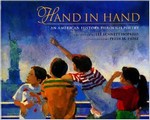Christmas is less than a week away and today I have a poetry title that will take you far away to the North Pole. You may not know this, but Santa likes to write poetry, haiku poetry, and in this title you will find twenty-five of these wonderful short poems that describe special moments in Santa's life.
Bob Raczka
Illustrated by Chuck Groenink
Poetry Picture Book
For ages 5 to 7
Lerner, 2014, 978-1-4677-1805-9
Everyone knows that Santa Claus (or Father Christmas as
some people call him) is an amazing man. He makes wonderful toys, has flying
reindeer that he trains, and he is able to crisscross the globe in a flying
sleigh to make millions of toy deliveries all in one night. Here is one thing
that you probably don’t know about Santa; he is a poet. Years ago his beloved
wife gave him a book filled with Japanese haiku poems, and he loved this
minimalist poetry form so much that he wrote some haiku of his own. Twenty-five
of these haiku appear in this book, one for each day from December 1st
to December 25th. Together the poems will give young Santa fans a
wonderful picture of what Santa’s life is like.
We begin on
December 1st with a poem about the mail that comes into Santa’s “overfilled
mailbox.” In fact, there are so many letters that it is as if “December’s first
storm” has come blasting into Santa’s mailbox.
On December 3rd
we find out that in spite of her age Mrs. Claus sometimes like to behave like
“a little girl,” She has a grand time making snow angels in front of her house
in the snow. On December 11th she gives her husband kisses under a
bunch of mistletoe and they “tickle like snowflakes.”
As the days
count down we read, among other things, about the working elves, the beauty of
the Northern Lights, and how Santa and Mrs. Santa string popcorn on thread to
hang on the Christmas tree. The poems describe these and so many other precious
moments that make December at the North Pole such a joy for Santa, his wife,
the elves, and the reindeer. We see how beautiful their world is, and how much
they enjoy their lives.
With lovely
illustrations and gem-like poems on every page, this is a book that children
and their grownups will enjoy sharing on the days leading up to Christmas.









